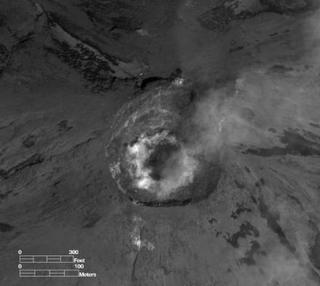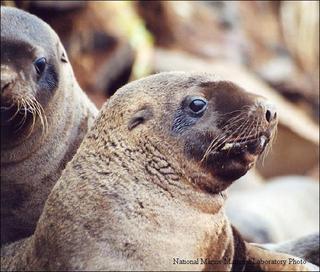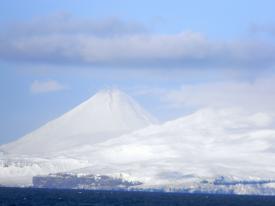Cleveland Volcano Releases Small Ash Cloud
By Alexandra Gutierrez
Thursday, April 19 2012
Cleveland Volcano has burped again.
According to the Alaska Volcano Observatory, the eruption occurred around 4:30am, and it sent a small ash cloud as high as six kilometers into the air. There is no real-time seismic monitoring network on Cleveland, but the activity was recorded by nearby stations on Okmok and Makushin volcanoes.
Cleveland is located on uninhabited Chuginadak Island, but it lies under a major international flight path. Today’s eruption did not interfere with air travel, but the aviation color code remains at orange. The remote volcano has shown regular activity over the past two years and continues to be on watch.
NOAA Proposes Removing Eastern Steller Sea Lions from Endangered Species List
By Alexandra Gutierrez
Wednesday, April 18 2012
While the population Steller sea lions in the western part of the state is still a subject of concern, the stock in eastern Alaska is experiencing a boom. In the past 15 years, the number of eastern Steller sea lions has doubled up to 70,000 animals, and now, federal biologists want to take the animal off the endangered species list.
Nearly 2,000 species have been placed on that list since it was created. If the eastern Steller sea lion is removed from it, it will be only the second animal to have achieved recovery status.
NOAA Now Accepting Feedback on Steller Sea Lion Regulations
By Alexandra Gutierrez
Tuesday, April 17 2012
Today, the federal government took its first step in preparing an environmental impact statement on commercial fishing restrictions in the western Aleutians. Members of the public can now offer official comment on how Steller sea lion protection measures have affected them.
The National Oceanic and Atmospheric Administration closed the Atka mackerel and Pacific cod fisheries in 2011 in an effort to limit food competition with an endangered stock of Steller sea lions. After a protracted legal battle, a federal judge determined that the regulations were appropriate, but that NOAA erred in not evaluating the impacts to the human environment through an impact statement. NOAA must now complete a statement by 2014, a process which could change the way those fisheries are managed.
Rumblings Continue at Cleveland Volcano
By Stephanie Joyce
Monday, April 16 2012
Two small explosions shook Cleveland Volcano on Friday. Scientists at the Alaska Volcano Observatory say the explosions didn’t produce detectable ash clouds. They’re just the latest in a series of low-level eruptions at the volcano.
There’s no real-time monitoring network on Cleveland, but scientists have been able to detect the eruptions using a network of distant air pressure gauges and seismic stations. Satellite images show slightly elevated surface temperatures in Cleveland’s crater, but the Observatory says there’s no sign of a new lava dome. The most recent dome was destroyed in an explosion two weeks ago.
Arctic Cod Bred in Captivity for First Time
By Stephanie Joyce
Thursday, April 12 2012
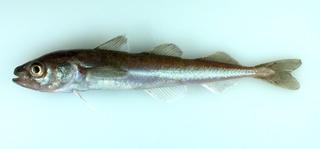 Juvenile Arctic Cod // B. Sheiko/NOAA
Juvenile Arctic Cod // B. Sheiko/NOAA
If breeding fish sounds tricky – it is. That’s why when the Vancouver Aquarium announced last week that biologists had successfully bred Arctic cod in captivity, it was hailed as a scientific breakthrough.
Arctic cod are one of the few fish in the world that thrives in temperatures below zero degrees Celsius, which makes them one of the most abundant fish in the far north. Aquarium senior scientist Tak Oyama says that makes Arctic cod a critical link in the polar ecosystem.
Bering Sea Ice Extent Breaks Records
By Stephanie Joyce
Tuesday, April 10 2012
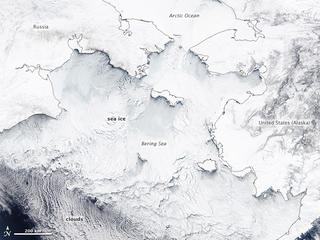 MODIS Image of Bering Sea Ice Cover on March 18, 2012 / NASA
MODIS Image of Bering Sea Ice Cover on March 18, 2012 / NASA
The Arctic has crossed the threshold from winter into spring. Scientists at the National Snow and Ice Data Center announced last week that Arctic sea ice reached its maximum extent on March 18 and is slowly beginning its summer retreat.
Despite a chilly winter in some part of the Arctic, the overall ice cover was the ninth lowest since the satellite record began in 1979. That’s still a sizeable quantity of ice – 5.9 million square miles, or roughly the size of the United States and Canada combined – but about 200,000 square miles less than the 30-year average.
Ocean Shows Resilience in Wake of Fukushima Disaster
By Alexandra Gutierrez
Thursday, April 05 2012
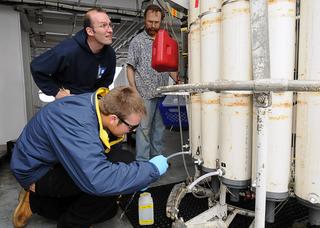 (Ken Kostel/Woods Hole Oceanographic Institution)
(Ken Kostel/Woods Hole Oceanographic Institution)
When the Fukushima nuclear power plant suffered a blowout a year ago, radioactive contamination of the Pacific Ocean was a major concern. People wanted to be sure that the marine ecosystem remained healthy and that the seafood they ate was safe.
To confirm that was the case, an international team of researchers took water samples as far as 400 miles out from the meltdown and tested them for radioactive isotopes. They published their research this month in the Proceedings of the National Academy of Sciences, and what they saw was mostly what they expected: Areas near Japan and in the line of strong currents experienced higher levels of radiation than usual, but the effect on marine life was minimal beyond Japan’s coast line.
Blast Shakes Cleveland Volcano
By Stephanie Joyce
Wednesday, April 04 2012
A small explosion shook Cleveland Volcano early Wednesday morning. There is no monitoring network on the volcano itself, but distant seismic stations picked up the blast, as they've picked up several similar explosions over the last few months.
Scientists at the Alaska Volcano Observatory said in a release that the eruption probably produced a small ash cloud. None of the recent explosions has interrupted air traffic, but Cleveland does lie on a major international and the Observatory is keeping the aviation alert level for the volcano at orange.
Fisheries Regulators Take On Preservation of Bering Sea Canyons
By Alexandra Gutierrez
Wednesday, April 04 2012
The North Pacific Fishery Management Council has decided to reexamine the management of the Bering Sea’s deepest canyons.
Regulators on the council voted to assess the impact commercial fishing has on Pribilof and Zhemchug canyons and to come up with potential preservation strategies if necessary.
The decision follows the release of a study by Greenpeace, the National Oceanic and Atmospheric Administration, and the University of California that looks at the role the canyons play in the ocean ecosystem.

